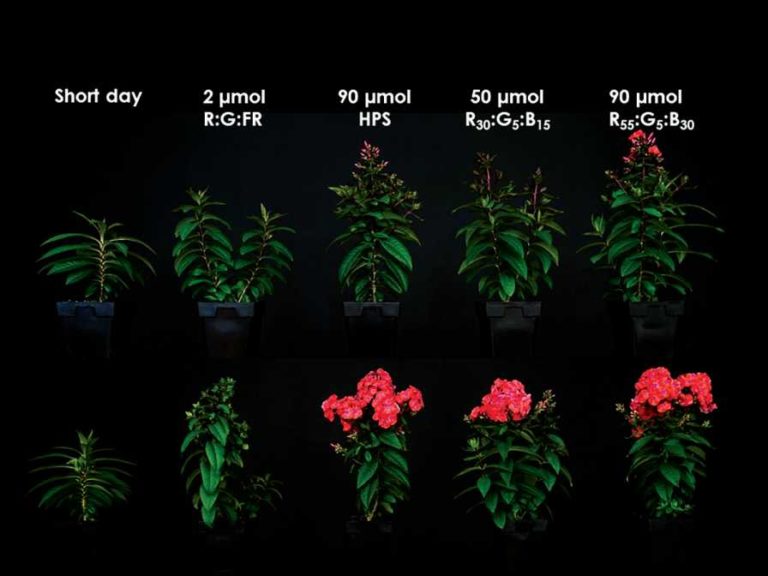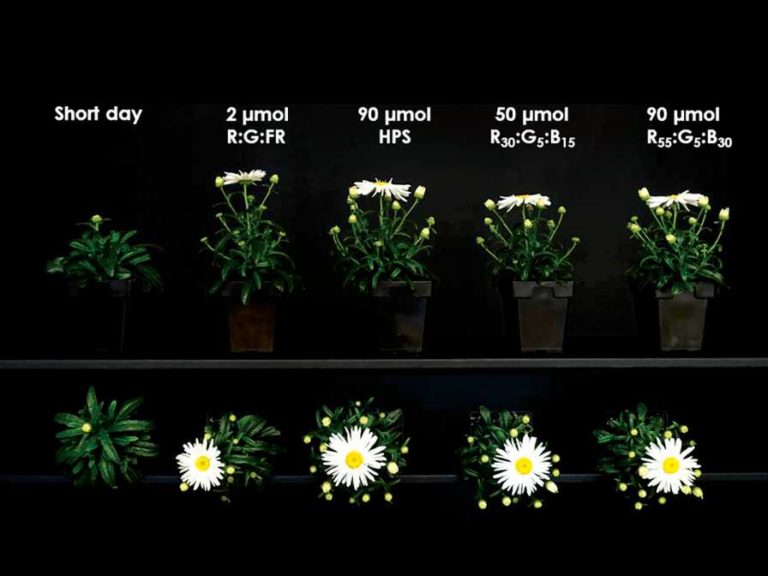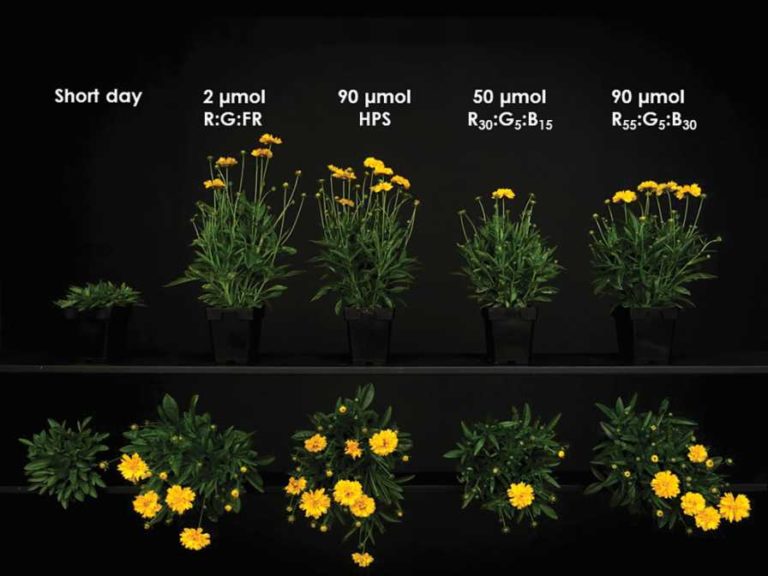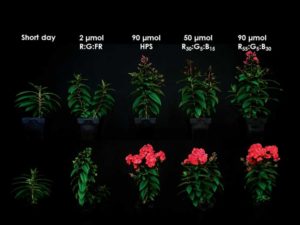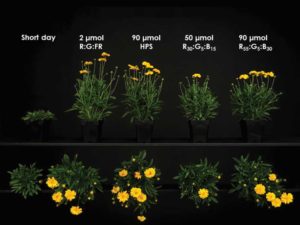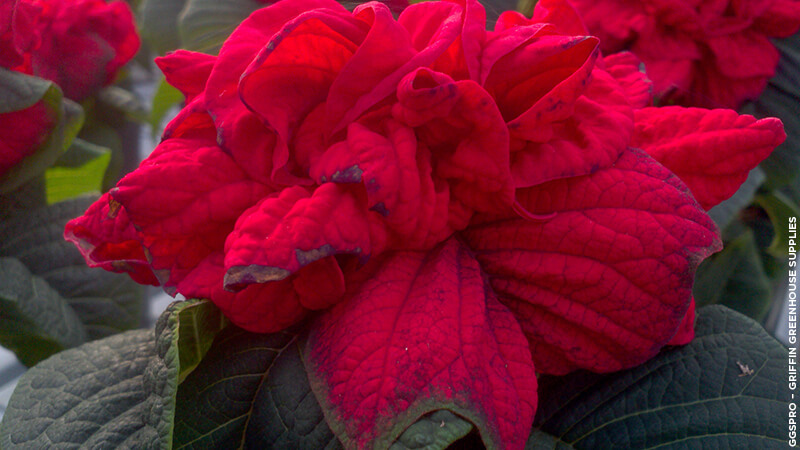How to Force Long-Day Perennials into Flower with High-Intensity LEDs
Growers who force perennials into flower know they will fly off the bench at retail, as most perennials are sold without flowers. Consequently, growers are looking for easy and profitable forcing protocols to produce a wide variety of high-quality flowering perennials in the spring.
Why Lighting Matters
Until recently, growers used incandescent lamps (INC) to provide low-intensity (~1 to 3 µmol∙m−2∙s−1) photoperiodic lighting to extend the day or interrupt the night. These lamps provided a low-red to far-red light ratio (R:FR) that induced long-day plants into flower. Unfortunately, a low R:FR can also result in unwanted stem elongation and stretching. However, the absence of far-red light can result in a delay or absence of flowering.
Recently, screw-in flowering light-emitting diodes (LEDs) providing a R:FR similar to now phased-out INC lamps have come on the market. Conversely, some growers utilize existing high-intensity supplemental lighting fixtures such as high-pressure sodium (HPS) lamps to create long days, as they provide red and far-red light that also induce flowering of long-day plants.
Generally, a higher daily light integral (DLI) from supplemental lighting results in a higher quality crop (i.e., more flowers, branches, and more compact plants), and flowering is hastened.
As LED efficiencies have increased, the use of LEDs for supplemental lighting as a replacement for HPS has increased as well. However, the question of whether LEDs used for supplemental lighting will be as effective in promoting flowering as HPS lamps arises, as most do not provide far-red light. Recent studies at Michigan State University have suggested that photoperiodic lighting providing a moderate intensity (≥15 µmol∙m–2∙s–1) of blue light can also induce long-day plants into flower, thus eliminating the need for far-red light. Additionally, a moderate amount of blue light can result in slightly more compact crops.
Therefore, we wanted to determine if light-emitting diode (LED; LumiGrow Pro 650e SV) supplemental lighting providing blue:green:red (B:G:R) light in µmol∙m−2∙s−1 B15:G5:R30 (total of 50 µmol∙m−2∙s−1) or B30:G5:R55 (total of 90 µmol∙m−2∙s−1) would 1) induce long-day perennials into flower and 2) provide sufficient increases in quality and reduction in crop time to justify the input costs.
Methods
Plants used: Plugs or liners of campanula (Campanula carpatica) ‘Pearl Deep Blue,’ coreopsis (Coreopsis grandiflora) ‘Early Sunrise,’ phlox (Phlox paniculata) ‘Glamour Girl,’ leucanthemum (Leucanthemum × superbum) ‘Spoonful of Sugar,’ catmint (Nepeta faassenii) ‘Purrsian Blue,’ and rudbeckia (Rudbeckia fulgida) ‘Goldsturm’
Greenhouse air temperature: 68°F
Photoperiod (short day): 9 hours for three weeks to promote vegetative growth prior to forcing under long days
Transplanting: Plants of each species were transplanted into 5.5-inch square pots and placed on benches under the five light treatments (Table 1)
Time to Flower
Phlox grown under supplemental lighting providing 50 or 90 µmol∙m–2∙s–1 flowered at similar times (Figure 1). Flowering was delayed by 17 days when grown under 2 µmol∙m–2∙s–1 of day extension photoperiodic lighting providing R:G:FR compared to LED supplemental lighting providing B30:G5:R55 light. Regardless of the source, supplemental lighting hastened flowering of phlox.
Leucanthemum flowered five days faster when grown under HPS lamps than under 2 µmol∙m–2∙s–1 of day extension photoperiodic lighting but flowered at similar times between the LED supplemental lighting treatments (Figure 2). Coreopsis and catmint (Nepeta) flowered at similar times regardless of supplemental or photoperiodic lighting treatments (Figure 3; Nepeta data not shown). However, flowering of rudbeckia and campanula was delayed by six to eight days and two to four days, respectively, when plants were grown under LED supplemental or photoperiodic lighting compared to plants under HPS lamps providing 90 µmol∙m–2∙s–1.
Plant Quality
When taking both branch and flower bud number into account, the highest quality leucanthemum, rudbeckia, and coreopsis were grown under 90 µmol∙m–2∙s–1 B:G:R LEDs (Figures 2 and 3), while the highest quality phlox were grown under 50 or 90 µmol∙m–2∙s–1 B:G:R LEDs (Figure 1). Providing supplemental lighting from HPS or LEDs produced higher quality campanula than under photoperiodic lighting. Catmint were of similar quality regardless of lighting treatments.
Take-Home Message
Providing long-day perennial plants with supplemental lighting containing greater than 15 µmol∙m–2∙s–1 of blue light is as effective at inducing flowering as low-intensity day extension lighting and supplemental lighting from HPS lamps. Additionally, some species were of higher quality when grown under LED supplemental lighting. Depending on a grower’s market, this may be a great enough increase in quality to warrant use of LED lights in their greenhouse production.




